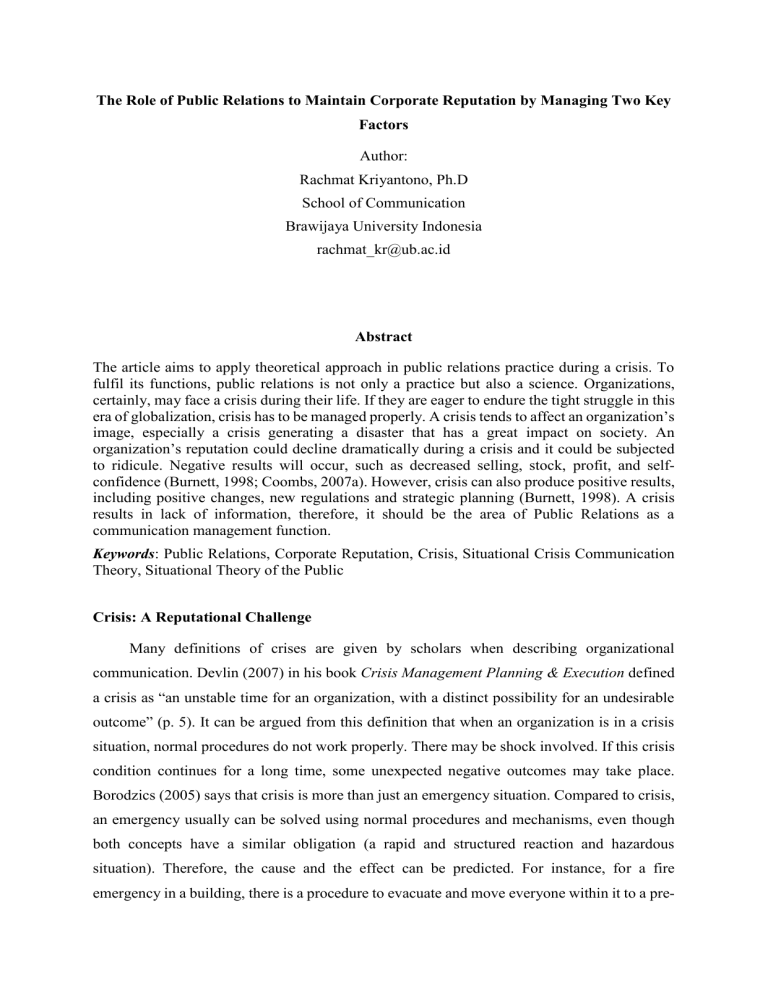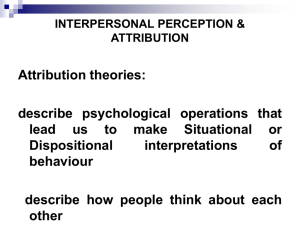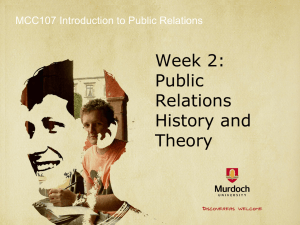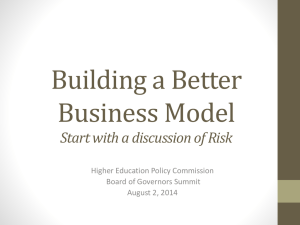The Role of Public Relations to Maintain Corporate Reputation by

The Role of Public Relations to Maintain Corporate Reputation by Managing Two Key
Factors
Author:
Rachmat Kriyantono, Ph.D
School of Communication
Brawijaya University Indonesia rachmat_kr@ub.ac.id
Abstract
The article aims to apply theoretical approach in public relations practice during a crisis. To fulfil its functions, public relations is not only a practice but also a science. Organizations, certainly, may face a crisis during their life. If they are eager to endure the tight struggle in this era of globalization, crisis has to be managed properly. A crisis tends to affect an organization’s image, especially a crisis generating a disaster that has a great impact on society. An organization’s reputation could decline dramatically during a crisis and it could be subjected to ridicule. Negative results will occur, such as decreased selling, stock, profit, and selfconfidence (Burnett, 1998; Coombs, 2007a). However, crisis can also produce positive results, including positive changes, new regulations and strategic planning (Burnett, 1998). A crisis results in lack of information, therefore, it should be the area of Public Relations as a communication management function.
Keywords : Public Relations, Corporate Reputation, Crisis, Situational Crisis Communication
Theory, Situational Theory of the Public
Crisis: A Reputational Challenge
Many definitions of crises are given by scholars when describing organizational communication. Devlin (2007) in his book Crisis Management Planning & Execution defined a crisis as “an unstable time for an organization, with a distinct possibility for an undesirable outcome” (p. 5). It can be argued from this definition that when an organization is in a crisis situation, normal procedures do not work properly. There may be shock involved. If this crisis condition continues for a long time, some unexpected negative outcomes may take place.
Borodzics (2005) says that crisis is more than just an emergency situation. Compared to crisis, an emergency usually can be solved using normal procedures and mechanisms, even though both concepts have a similar obligation (a rapid and structured reaction and hazardous situation). Therefore, the cause and the effect can be predicted. For instance, for a fire emergency in a building, there is a procedure to evacuate and move everyone within it to a pre-
designated safe place. On the other hand, the jeopardy of critical decision making is more difficult in a crisis situation due to the poor understanding of the situation. Seeger, Sellow &
Ulmer (1998, cited in Smudde, 2001), defined a crisis as “a specific, unexpected, and nonroutine event or series of events that create high levels of uncertainty and threaten or are perceived to threaten an organization‟s high-priority goals” (p. 34). This definition is closely linked to Burnett‟s idea that focuses on the stages of a crisis.
Burrnett (1998) stated that the crisis is “composed of a continuum, beginning with an incident, continuing with an accident, followed by a conflict, and ending with a crisis, the most serious form of disruption” (p. 476). In this context, “high levels of uncertainty and threaten…”
(In Seeger’s definition above) is likely to be similar to the concept of conflict situation in
Burnett‟s idea. From Penrose (2000) and Fink (Duke & Masland, 2002), the terms conflict and disruption, in Burnett‟s idea described above, can also be explained in that the event becomes more serious and worse so that it frequently stimulates the mass media and the government to investigate frequently and it could be news headlines every day. It may interfere with the organization’s daily activities and create negative public opinions. In fact, further exploration of public opinion during the mudflow crisis is warranted to gain in depth information about the crisis. Another explanation of the nature of crisis emphasizes that a crisis causes a physical and non-physical disruption such as a life threatening event (causing injury or loss of life), and destructive to a system of the organization and the community’s environment as a whole
(Duke & Masland, 2002; Kouzmin, 2008). Harrison (2005) when conducting his research on communication strategies as a basis for crisis management gave a comprehensive definition of a crisis. He said that “A crisis is a critical period following an event that might negatively affect an organization in which decisions have to be made that will affect the bottom line of an organization. It is a time of exploration requiring rapid processing of information and decisive action to attempt to minimize harm to the organization and to make the most of a potentially damaging situation” (p.11).
From the definitions above, it can be concluded that a crisis can be understood by recognizing its characteristics. As a result, the characteristics determine the differences between a crisis and an issue. First , a crisis is a specific event. Organizations may face one type of crisis, such as an employee demonstration or a product crisis. However, it is also possible that at the same time, an organization may face two or more types of crisis. This leads to a discussion about the source that triggers the crisis. From Burnett (1998), Harrison (2005) and White and Mazur (1995), it can be summarized that a crisis can generally be caused by two
sources, those inside the company and those outside. Inside factors are human, management or organizational, and technological whereas outside factors are regulatory, malevolent, and confrontational with the public.
Furthermore, a poor relationship between an organization and the public can trigger a confrontation crisis. This occurs when the public expresses its outrage due to its dissatisfaction with the company’s operations. Equally, a crisis of malevolence occurs when a person or a group has a desire to harm the company, such as sabotage or a terrorist group bombing business areas that affect the company’s activities. However, it is possible to categorize a natural disaster as an outside factor which causes the crisis. Second , a crisis is unexpected. A crisis tends to threaten the life of the organization or the public, therefore no one in the organization expects it to happen. The crisis occurs as part of an organization’s operation. The results will be unexpected because it can produce negative outcomes such as great damage, pose a threat or challenge, many people could die, and it could change the social and cultural system. As a consequence, it has an effect on the company as well as its public, the products and its reputation (Fearn-Banks, 2012).
Third , a crisis creates high levels of uncertainty. At the beginning of the crisis, it is natural that rumours start, because everyone has a chance to predict what is happening. To solve this, public relations officers must be proactive and provide a channel of communication through which the truth is given to the public concerning the situation. According to Harrison (2005), it can be said that the activity of public relations officers to provide pertinent messages and open a channel of communication during and after the crisis is called a crisis communication.
According to all definitions, the mudflow in Sidoarjo, Indonesia can be categorized as a crisis.
It is a physical crisis which is also causing physical damage and it is a non-physical crisis which is creating serious danger to the culture and values of a particular social system. Physical damage caused the victims to move away from their homes to different places so that they also missed their social-cultural life, such as social interaction, and family bonds. That situation is similar to Cernea‟s concept of “forced displacement”; people moved because the mudflow submerged its land.
Finally, the best thing to do is make an anticipatory plan. I argue that it is the same as an issue plan. Kate Miller (1999) said that a crisis will occur if a company fails to monitor issues, including environment scanning, within its operating environment. As a result, it becomes public knowledge and even triggers public outrage. According to Miller (1999), it seems that the main characteristic of a crisis is whether the public’s outrage takes place. It can be said that
a crisis is not triggered by an event but it results from an event (Harrison, 2005) and public and management’s interpretations and reactions to it (Zyglidopoulos, 1999). Hayes’s research
(Dyer, 1995) showed that the crisis depends on how the company responds to an event. From her study, LaPlant (1999) found that the Dow Corning company experienced a crisis because they produced unsafe silicone implants in the late 1980s. Consequently, this company was bankrupt by 1995. In fact, ten years before the crisis (in 1977) and before the case expanded, there was a lawsuit for faulty implants. In this situation, before the actual crisis happened, the company should have been aware that the issue of product safety could tend to be a problem during the following ten years. From the descriptions above, it can be said that there are two types of crises: (1) the crisis that follow from ignoring developing issues. Regester & Larkin
(2008, p. 95) called “an issue ignored is a crisis ensured.” (2) the unanticipated, unexpected crisis that comes about because of an external event that might be natural, industrial, political, economic or social. These crises depend on how effective issue and crisis management conducted by the company.
Crisis Communication and Crisis Management
Sometimes the event is recognized only by the employees of an organization, and is invisible to outsiders (Devlin, 2007). However, if management does not respond quickly by giving true and trusted information as well as a proper course of action it will raise the escalation of a crisis event and, certainly, could be more difficult to manage it. In the mudflow crisis, Sidoarjo, East Java, for example, the Indonesia Minister of Energy and Minerals,
Purnomo Yusgiantoro conceded that there was tardiness in handling the crisis, because it was late to close the hole of the well and to move the Pertamina pipelines that blew up and made the mudflow wider (Septian, 2008).
In addition, crises might involve a lack of information and the failure to provide and control the flow of information accurately and efficiently is one of the biggest mistakes during a crisis situation (Duhe, 2005). Several studies have demonstrated this. Maggart (1994), in her study on the Bowater Incorporated’s crisis communications, found that the company did not have a crisis plan, did not manage the internal communications properly, and did not keep the human element in their communication messages either. Schimmoler (2008) and Lordan
(2005) in their studies on the International Coal Group dealing with the Sago Mine Disaster revealed that the company conducted a miscommunication about the fate of the victims.
Without checking properly, the company announced that the 11 was survive and one victim
died. It made hope from the families. After evacuation finished, actually, 11 victims died and only one was survive.
On the other hand, Duke and Masland (2002) presented a different model to describe an effective crisis communication. In their study on the tragic campus death of a student, they found that the university had good media publicity because it had a crisis communication plan and gave proper information to the public. Madere (2008) found that the South eastern
Louisiana University could manage the Hurricane Katrina crisis because it consistently and quickly delivered information through its website. Moreover, Chong (2006) found Singapore’s government could deal with the SARS crisis because it built trust through its communication, such as openness, care, fairness, and public participation. These studies appeared to be a reasonable consensus on the importance of information in crisis situation. As stated by Scanlon
(1975), cited in Harrison (2005) that “every crisis is also a crisis of information…. failure to control this crisis of information results in failure to control the crisis” (p. 12).
Finally, when will crisis communication be needed? It is common that situations such as “mergers, acquisitions, government investigations, lawsuits, reorganizations, product recalls or product tampers, boycotts, bankruptcy, scandals, proxy fights, environmental problems need a crisis communication plan” (Carney & Jordan, 1993, cited in Dyer, 1995, p. 39). This is because these events are news-worthy for the mass media. Every day during the crisis, the company will come under the scrutiny of the mass media. Therefore, public relations should create good media relations (Syahri, Kriyantono, Zulkarnaen, 2015). News, on the other hand, is the result of media construction about reality that sometimes differs from reality. News is commonly thought of as a second hand reality. It means that news is selected and arranged based on media considerations. McNair (1994) said that there are many factors that determine news content: the political economy approach, organizational approach, and cultural approach.
The political economy approach consists of power (such as government and political party), the owner, and business interest that influence the news. Organizational approach consists of the system of organization, salary, and job description. Furthermore, the cultural approach consists of the social-cultural of the community in which mass-media take place. In similar way, Shoemaker and Reese (1996) gave some factors that determine or influence news production, such as reporter background, media routine, organizational structure, extra-media power, and state ideology.
Pertinent to this context, Altheide and Snow (cited in Dyer, 1995) call it media logic:
It is not simply that news agencies use certain perspectives and techniques in helping them to define, select, and produce news. Of course they do, but this is hardly new.
Media logic refers to the way in which those organizing features are incorporated into perspective and activities of the audience members themselves, and are in turn taken for granted as reality… In our age, news is not merely content; it is form and authority based on that form. (p. 38). Upon reporting the crisis frequently, media makes the situation visible to the external public.
Commonly, a crisis evolves through three stages (Devlin, 2007; Smudde, 2001). These are a pre-crisis stage, a crisis (acute crisis), and post-crisis. The pre-crisis occurs when the serious situation begins and the company recognizes it. The crisis (acute crisis) occurs when the situation cannot be managed properly by the company, so that the situation becomes visible outside the company. The post-crisis is when the crisis is contained and the company attempts to keep its image or failing that lose it. If the organization faces a crisis situation, it is better to take action as soon as feasible after being aware of the crisis situation. The organization’s attempt to deal with the crisis is called crisis management. Devlin (Devlin, 2007) stated that
“crisis management is special measures taken to solve problems caused by a crisis” (p.1).
At the beginning, organizations may restrict or confine the area of the crisis to minimize the effect of damage on the organization. It can be concluded that the aim of crisis management is to reduce or stop the effects of the main events on the company by preparing and implementing some strategies and tactics. However, the evidence about crisis management is somewhat contradictory. From her study, Miller found that there is a wrong assumption among some managers in conducting crisis management. They often assume that crisis management is once only activity and a crisis plan will be designed when the crisis happens. However, crisis plan is an on-going and continuous process (Burnett, 1998; Miller, 1999; Penrose, 2000). It means that crisis management should be started by issue management (Miller, 1999).
The literature provides clear theoretical perspectives about effective issue and crisis management. Crisis management envisages both a crisis communication and a recovery plan.
Without recovery, it will be no organization –it goes out of business. Hence, these theoretical perspectives will be applied as a basis to explore how the company’s policies deal with the mudflow crisis.
Key Factors of maintaining the reputation in a Crisis
Issues and crisis are socially constructed from the individuals involved in it. The constructions are subjective, free-meanings and relatives. Furthermore, the constructions which appear in
perceptions, attitudes, and actions are highly influenced by the personal backgrounds, including the experiences from the interactions before, during, and aftermath of the crisis. Hence, Public relations have roles. They are able to stimulate and shape the constructions from the individuals who are predicted to be involved in the crisis. This has an aim as the direction for the constructions to go through the organization’s positive reputation. Then, how should do to gain positive social constructions? How can Public relations influence the constructions?
In this article, I am offering two key-factors of conducting a crisis management. These two keys should be conducted from the beginning of the crisis. These keys are the basis to plan proper programs deal with the crisis in order to maintain the reputation. The factors have been proven in the author’s research: crisis management deal with mudflow crisis (Kriyantono,
2011) and type of public in the presidential issue (Magdalena, Kriyantono, & Pratama, 2014).
Those factors keys are: a. To identify the public with its responses. Public relations must identify how the public’s responses to the messages delivered by public relations. From the identification process, PR may be able to gain information that can be used to determine either categories of public or relevant communication strategies. This first key is based on the assumption from Grunig’s
(1979, p. 741) Situational Theory of the public:
“Each person will attempt to cope with a situation in a way that he perceives will work best in that situation.” b. To direct all the strategies dealing with crisis to be public oriented. It means that all the strategies should aim to fulfill the public’s need and to help them to avoid threatening, physically and psychologically. It is based on Coombs‟ (2007, p. 165) idea of Situational Crisis
Communication Theory:
“It would be irresponsible to begin crisis communication by focusing
on the organization’s reputation” (Coombs, 2007a:165).
Who and How is Your Public?
This section describes the Situational Theory of the Public, one of the theories about the public which is pertinent to this current research. Generally, this theory describes the attitude and communication behaviour of the public toward the organization (Dewey, 1927 cited in Grunig, 1979). Hence, it can be used to depict the public’s perceptions, attitudes and behaviours during the mudflow crisis. This theory has several assumptions (Grunig, 1979):
It assumes that behaviours of different persons will be more consistent in the same situation than will be the behaviour of a single person in different situations. It also assumes that a person‟s perception of a situation best explains when and how he will communicate about that situation. Furthermore, it assumes that each person will attempt
to cope with a situation in a way that he perceives will work best in that situation. (p.
741)
From the assumptions above, it can be summarized that public behaviour changes easily and the change will depend on two factors such as the situation and the opportunity to discuss it with others. Grunig (1979) developed this theory based on Dewey’s idea about the evolution of the public. Dewey (cited in Grunig, 1979) theorized that there are three steps of the public’s evolution; firstly, having a similar problem; secondly, recognizing the problem, and thirdly, giving a response to a particular action. As a result of this evolution, there are three types of public: a latent public, an aware public, and an active public. The latent public is a group that has the same problem but cannot identify and describe the problem. However, if a group is familiar with a problem it becomes an aware public. Lastly, the active public is a group which discusses and responds (using opinions or actions) to the situation (Grunig, 1979; Sriramesh,
Moghan, & Wei, 2007). As an aware public, the public is likely to have knowledge or information about the problem from communication activities. If the public conducts particular actions such as conducting demonstrations, giving statements to mass media, and creating discussion boards, it changes to an active public.
Broadly speaking, Grunig (1979) used this Situational Theory of the Public to classify the public into two specific categories: how they communicate the ideas and how they tend to respond to the issue. Accordingly, this theory is an alternative model to measure public opinion.
He used it to reveal communication behaviour of the public that arises from the issue of corporate social responsibility. Other prominent studies also used this theory to measure public opinion. For instance, Sriramesh et al. (2007) applied Situational Theory of the Public to investigate the communication behaviours of retail consumers in Singapore. They revealed that most consumers were an aware public but tended not to actively express the feelings because of cultural constraints. Lee & Rodriguez (2008) tested this theory to measure four types of public in relation to an anti-bioterrorism information campaign. They found that the four types have their own individual characteristics, such as media consumption habits, information sources, and behaviours. Aldoory, Kim, & Tindall (2010) conducted an experimental study to test the influence of perceived shared experience on this theory in terms of food terrorism in
USA. This study revealed that the public tended to more actively search for information, recognize the problem, and be more involved when it had the same perception of the information. I inquired about the victims’ attitudes toward the problem of the mudflow and how they dealt with the crisis management used. Although this theory has often been overlooked, it has not been applied to explore the victims‟ perception or attitude to the
communication programs during the mudflow crisis in Indonesia, particularly by using a qualitative method.
As a result of describing the perceptions or attitudes and the communication behaviour of the public, this theory also encompasses variables of communication behaviour and variables of the perception of the situation. Communication behaviours have two sub-variables, information seeking and information processing. Grunig (1979) said that “information seeking is an active communication behaviour …. information processing is a passive communication behaviour” (p. 741). It is called active behaviour because persons must be active to gain information by planning what kind of information they need, searching, selecting the media and the content, and trying to understand it. When adapting to a particular situation, people are likely to feel that their information is not suitable to deal with a new situation. Consequently, they tend to search for information that can be used in that situation. Information determines people’s perceptions and attitudes. If the attitude is useful to deal with a situation, it will still be used. However, it is possible that people create new attitudes if the old attitudes are not suitable to the situation. On the other hand, information processing is called a passive action because people receive the information without deliberately searching for it. They do not realize that they are involved in an information processing activity (Grunig, 1979). Due to the globalization era, it is difficult to differentiate between the two sub-variables above. Therefore,
Kim and Grunig (cited in Aldoory, et al., 2010) introduced the new concept of information gaining that is a combination of information processing and seeking.
Further observation of the victims’ behaviour during the mudflow crisis found that they actively seek information by frequently demonstrating against the company and the government’s offices to gain information. They felt that neither the company nor the government gave clear explanations about what happened. For example, social warnings, compensation, and what people should do was not relayed to the public. For public relations officers, the concepts of active and passive communication behaviour can help them to select a medium to convey messages and to plan communication strategy to encode messages. If the public is assumed to be active, public relations officers can choose specialized media (for example, internet, booklets, seminars). However, the mass media is the most effective media for the passive public. The messages must be arranged attractively to draw the public’s attention and keep their interest in the message (Grunig, 1979).
Magdalena, et al (2014) applied this theory to identify who is the public through perception, attitude and communication behavior during the presidential issue in Malang
region, Indonesia. The researcher concluded that generally the majority type of the public was problem-facing behavior type. With the high problem recognition level and low constraint recognition. The research suggested the government to deliver socialization about the presidential election because many public still do not know and do not understand about political terms during presidential election so that would eventually create a smart public in the election, creating media center or an open information center for the public to provide the whole information about the steps of 2014 presidential election actvities, receiving open suggestions to make sure that the society’s aspiration related to 2014 presidential election can be well delivered.
In addition, the Situational Theory of the Public also consists of variables of situational perception. According to Grunig (1979) this variable has four dimensions: problem recognition, constraint recognition, referent criterion, and level of involvement. Grunig (1979) defined these four concepts as:
Problem recognition [emphasis added] represents the extent to which a person recognizes that something is missing in a situation so that he stops to think about the situation. Generally, when a person perceives a situation as problematic, he inquires about the situation. Thus, problem recognition increases the probability that a person will communicate about a situation. Constraint recognition [emphasis added] represents the extent to which a person perceives constraints in a situation that limit his freedom to construct his own behaviour. If a person realizes that his freedom to move in a situation is limited, information that helps him to understand alternative movements has little relevance, and the probability that he will communicate is reduced. A referent criterion [emphasis added] is the old attitude of person which tells him what to do in the situation. Finally, level of involvement [emphasis added] is the extent to which the person connects himself with the objects in the situation. (p. 743).
The combination of problem and constraint recognition results in four types of perceived situation: problem facing behaviour, constrained behaviour, routine behaviour and fatalistic behaviour (Grunig, 1979). Furthermore, Grunig explained that the criteria of problem facing behaviours are high problem recognition and low constraint recognition. If the members of the public have high problem recognition and low constraint recognition, they have a constrained behaviour. A routine behaviour will occur when the public has a low problem recognition and low constraint recognition. Finally, the combination of low problem recognition and high constraint recognition will create fatalistic behaviour.
The Public Safety as First Priority
The other theories, The Situational Crisis Communication Theory (SCCT) and
Attribution Theory will now be discussed in turn. SCCT can be used to explain the reaction of
the public to a crisis and the crisis strategies applied by public relations. The public has a particular attribution about the crisis that determines the company’s reputation. Therefore, this theory tries to recognize some aspects of the crisis that influence the public’s attribution
(Coombs, 2007a, 2007b; Coombs & Holladay, 2002). The key point of this theory, according to Coombs (2007b; Coombs & Holladay, 2002), is it emphasizes protecting the public from damage, rather than protecting the company’s reputation. This is the first priority to warrant safety and survival when facing a crisis situation (Reynold, 2002, cited in Veil, et al., 2005).
In turn, it can develop positive attribution of the public to the company’s reputation. Coombs
(2007b) stated:
It would be irresponsible to begin crisis communication by focusing on the organization’s reputation. To be ethical, crisis managers must begin their efforts by using communication to address the physical and psychological concerns of the community. It is only after this foundation is established that crisis managers should turn their attentions to reputational assets. (p. 165).
It appears that the concept „reputation‟ means that the company has “legitimacy‟.
Metzler (2001, cited in Veil, et al., 2005, p. 19) and Culbertson, Jeffers, Stone, and Terrell
(1993, p. 18) stated that legitimacy is “an organization’s right to exist”. In short, legitimacy is approved by the community (Habermas, 1975, cited in Culbertson, et al., 1993) and developed by two aspects: an organization‟s competence and character (Veil, et al., 2005). If the company operates its business effectively, it will be called competent. Furthermore, character can be gained if the public perceives that the company has programs that are concerned with social community (Veil, et al., 2005; Zyglidopoulos, 1999). All programs that are concerned with social community, then, can be seen as corporate social responsibility (CSR). CSR is the implementation of the concept that community or the public is the first priority, because the public has the ability to influence and is influenced by the company’s activities. The company needs to do something for social welfare as well as producing and selling goods or services
(Turker, 2009).
Therefore, the public’s interpretation is important to support an organization’s competence (Veil, et al., 2005) and competence is the aspect of the model of reputational crisis that determines the degree of the company’s reputation (Zyglidopoulos, 1999). To gain a positive interpretation, the company must satisfy the expectation of its public. Therefore, it can be said that an organization’s character can be defined by its community concern. In terms of the company’s reputation, the Situational Crisis Communication Theory describes three factors in a crisis situation that potentially threaten the reputation of the company. These three factors
are an initial crisis responsibility, a crisis history, and a prior relational reputation. The initial crisis responsibility is the level of the public’s attribution toward the company’s responsibility of the crisis: whether the company is perceived to have caused the crisis or not (Coombs, 2007a,
2007b). Thus, the public attribution is determined by how the crisis is being framed. Druckman
(2001) cited in Coombs (2007b) described that there are two types of frames: the mass media’s frames and the public’s frames. The mass media frames are created by the mass-media (news, advertising, opinion columm), while the public frames are the inherent pattern of knowledge that the public already has to understand its environment (also see Johansson, 2007; Littlejohn
& Foss, 2008). It is important to note that mass media frames have the power to influence or form public frames, because messages can be frequently disseminated to the public. Through their study, Cho and Gower (2006) revealed that human interest news exposure in the media made respondents to be more empathetic to victims and led them not to blame the company.
From Druckman‟s (2001, cited in Coombs, 2007b) idea about frames, it can be concluded that public relations officers should manage messages (this can be called communication re-engineering) with the aim of influencing both frames. A case study conducted by Duhe & Zoch (1995), for example, showed the importance of framing the media‟s agenda during a crisis. They found that the Exxon Company had successfully dealt with a petroleum explosion crisis by framing its messages. The frames used were that the company took full responsibility for the impact of the crisis, gave sympathy to the community, and showed concern for the community’s safety. Thus, these messages were reported by the media so they then became the media’s frames. Duhe & Zoch (Duhe & Zoch, 1995) also found that the company aimed to maintain its public’s interest (such as the employees, the community, and the media) rather than maintain the corporate reputation.
The crisis frames, in addition, form three clusters of crisis, called crisis types: a victim cluster, an accidental cluster, and an intentional cluster (Coombs, 2007a, 2007b). According to
Coombs, the company is categorized as the victim cluster when the public considers that the company is not the cause of the event. In other words, the company is judged as being a victim of the crisis. Examples of this cluster are earthquakes, landslides, floods, a homicide within the company, or product sabotage. The accidental cluster emerges if the public considers that the event is accidentally caused by the company. In other words, the company is perceived as not deliberately causing the event. However, an intentional cluster occurs when the public decides that the event happened because of the company’s mistakes. Coombs (2007b, p. 167) gave examples such as: “technical-error product harm and technical-error accident” as being
accidental clusters; “human-error accident, human-error product, organizational misdeed” would be considered an intentional cluster”. From Coombs (2007a, 2007b), it can be concluded that there is a negative correlation between the victim cluster and the attribution level of crisis responsibility. On the contrary, there is a positive correlation between the intentional cluster and the attribution level of crisis responsibility (also see Cho & Gower, 2006).
Furthermore, the company’s reputation, according to Coombs (2007a, 2007b) is also shaped by crisis history and prior relational reputation. Crisis history occurs when the public perceives that the company has experienced the same situation previously. Coombs (2007a) called a crisis history “consistency” (p.3). Prior relational reputation is the public’s perception of how the company has cared for the public in previous situations. If the company did not treat the public well on the other occasions, it has a bad prior relational reputation (Coombs, 2007a,
2007b). Coombs (2007a) called the prior relational reputation “distinctiveness” (p. 3). From the description above, it is obvious that this theory is closely linked to Weiner’s theory of attribution (Choi & Lin, 2009; Coombs, 2007a, 2007b; Jeong, 2009). The Attribution Theory states that a person tends to seek the information about the causes of a negative and unexpected event. The public tends to attribute the responsibility for a crisis situation to a particular person, because it has an emotional response to the crisis. If the company is attributed as the cause of the event, its reputation will fall and this situation could evoke public anger. As a result, the public will probably avoid interaction with the company (Weiner, 2006 cited in Coombs,
2007a; Coombs, 2007b).
Jeong (2009) connected these theories in his study of the public’s responses to an oil spill. He found that the public tended to give negative attribution to the company when it knew that the company had a negative crisis and relationship history. In a similar way, negative attribution stimulated the public to give punitive responses toward the company. Another study by Choi & Lin (2009), focused on how public perception and emotion influence a crisis strategy by emphasizing that dependent attribution emotions (such as anger, sympathy, fear) and independent attribution emotions (such as alertness and confusion) coexisted to influence organizational reputation. Attribution Theory and Situational Crisis Communication have often been overlooked. Most research has focused on an organization-centered approach rather than a public approach (Choi & Lin, 2009). For instance, Sisco, Collins, and Zoch (2010) undertook content analysis to examine the response strategy of the American Red Cross when dealing with its crisis and compared it with Situational Crisis Communication Theory. Hence, this
current research focuses on the public’s perspective of the mudflow crisis. There appears to be little qualitative research available that centered on the public approach (Moffitt, 1992).
Therefore these theories were applied using a qualitative method in order to study the crisis from a different perspective:
• All victims or potential victims should receive instructing information, including recall information. This is one-half of the base response to a crisis.
• All victims should be provided an expression of sympathy, any information about corrective actions, and trauma counseling when needed. This can be called the “care response.” This is the second-half of the base response to a crisis.
• For crises with minimal attributions of crisis responsibility and no intensifying factors, instructing information and care response is sufficient.
• All victims or potential victims should receive instructing information, including recall information. This is one-half of the base response to a crisis.
• All victims should be provided an expression of sympathy, any information about corrective actions, and trauma counseling when needed. This can be called the “care response.” This is the second-half of the base response to a crisis.
• For crises with minimal attributions of crisis responsibility and no intensifying factors, instructing information and care response is sufficient.
• For crises with strong attributions of crisis responsibility, add compensation and/or apology strategies to the instructing information and care response.
• The compensation strategy is used anytime victims suffer serious harm.
• The reminder and ingratiation strategies can be used to supplement any response.
• Denial and attack the accuser strategies are best used only for rumour and challenge crises.
Conclusion
It can be concluded that Situational theory of the Public and Situational Crisis
Communication Theory help Public Relations practitioners to do their Jobs. The former will guide how crisis management, including crisis communication, should be planned and conducted. The company must identify its public: how the public communicate and how the public perceive toward the crisis situation. In addition, the latest, will provide guideline to focus on the public safety and needs. If the public feels to be priority, it will attribute the
company positively or favourably. The two theories become the tenet of public relations theories and provide practitioners important knowledge to deal with crisis situation.
References:
Borodzicz, E. P. (2005). Risk, crisis, and security management . West Sussex: John Wiley & Sons Ltd.
Burnett, J. J. (1998). A strategic approach to managing crisis. Public relations Review, 24 (4), 475-
488.
Coombs, W. T. (2007a). Attribution theory as a guide for post-crisis communication research. Public
Relations Review, 33 , 135-139.
Coombs, T. (2007b). Protecting organization reputation during a crisis: The development and application of situational crisis communication theory. Corporate Reputation Review,
10 (3), 163-176. Coombs, W. T., & Holladay, S. J. (2002). Helping crisis managers protect reputational assets: Initial test of the Situational Crisis Communication Theory. Management
Communication Quarterly : McQ, 16 (2), 165-187.
Culbertson, H. M., Jeffers, D. W., Stone, D. B., & Terrell, M. (1993). Social, Political, And
Economic Contexts In Public Relations: Theory and Cases. New Jersey: Lawrence Erlbaum
Associates Publisher.
Devlin, E. S. (2007). The crisis management planning and execution . New York: Auerbach Publication.
Duhe, S. F., & Zoch, L. M. (1995). A case study: Framing the media’s agenda during crisis. Public
Relations Quarterly, 39 (4), 42-45.
Duke, S., & Masland, L. (2002). Crisis communication by the book. Public relations Quartely,
47 (3), 30-35.
Dyer, S. C. (1995). Getting people into the crisis communication plan. Public Relations Quarterly,
40 (3), 38-41.
Fearn-Banks, K. (2007). Crisis Communication: A Casebook Approach . New Jersey: Lawrence
Erlbaum.
Galloway, C., & Kwansah-Aidoo, K. (2005). Getting to grips with issues management and crisis communication. Dalam C. Galloway & K. Kwansah-Aidoo (Eds.). Public Relations Issues and
Crisis Management . Victoria: Thomson-Social Science Press.
Grunig, J. (1979). A new measure of public opinions on corporate social responsibility. Academy of Management Journal, 22 (000004), 738-764.
Harrison, G. (2005). Communication strategies as a basis for crisis management including use of the internet as a delivery platform.
Doctor of Philosophy, Dissertation, Georgia State University,
Georgia.
Jeong, S.-H. (2009). Public’s Responses to an oil spill accident: A test of the attribution theory and situational crisis communication theory. Public Relations Review, 35 , 307-309.
Johansson, C. (2007). Goffman’s sociology: An inspiring resource for developing public relations theory. Public Relations Review , 33, 275-280.
Kouzmin, A. (2008). Crisis management in crisis? Journal of Administrative Theory and Praxis, 30 (2),
155-183.
LaPlant, K. (1999). The Dow Corning crisis: A benchmark. Public Relations Quarterly, 44 (2), 32-33.
Lee, S., & Rodriguez, L. (2008). Four publics of anti-bioterrorism information campaigns: A test of the situational theory. Public Relations Review, 34 , 60-62.
Littlejohn, S. W., & Foss, K. (2008). Theories of human communication . California: Thomson
Wadsworth.
Kriyantono, R. (2011). Critical ethnograhy of crisis management dealing with a mudflo crisis. Doctoral
Thesis, Edith Cowan University, Western Australia.
Madere, C. M. (2008). Using the university website to communicate crisis information. Public Relations
Quarterly, 52 (2), 17-19.
Maggart, L. (1994). Bowater incorporated: A lesson in crisis communications. Public Relations
Quarterly, 39 (3), 29-31.
Miller, K. (1999). Issues management: The link between organization reality and public perception.
Public Relations Quarterly, 44 (2), 5-10.
Penrose, J. M. (2000). The role of perception in crisis planning. Public Relations Review, 26 (2), 155-
171.
Regester, M., & Larkin, J. (2008). Risk isues and crisis management in public relations: A casebook of best practice . London: Kogan Page.
Schimmoeller, Michael. (2008). The Sago mine disaster: Can lightning strike twice? Public Relations
Quarterly, 52 (2), 38-42.
Sisco,H.F., Collins, E.L., & Zoch, L.M. (2011). Breadth or depth? A content analysis of the use of public relations theory. Public Relations Review , 37, 145–150
Smudde, P. (2001). Issue or crisis: A rose by any other name... Public Relations Quarterly, 46 (4), 34-
36.
Sriramesh, K., Moghan, S., & Wei, D. L. K. (2007). The situational theory of publics in a different cultural setting: Consumer publics in Singapore. Journal of Public Relations Research, 19 (4),
307-332.
Turker, D. (2009). Measuring corporate social responsibility: A scale development study. Journal of
Business Ethics, 85 , 411-427.
Veil, S. R., Liu, M., Erickson, S., & Sellnow, T. (2005). Too hot to handle: Competency constrains character in Chi-Chi’s Green Onion crisis. Public Relations Quartely, 50 (4), 19-22.
White, J., & Mazur, L. (1995). Strategic communication management: Making public relations work .
Wokingham Addison-Wesley.
Zyglidopoulos, S. (1999). Three essays on reputational crises.
Doctor of Philosophy, McGill
University, Montreal, Canada.









